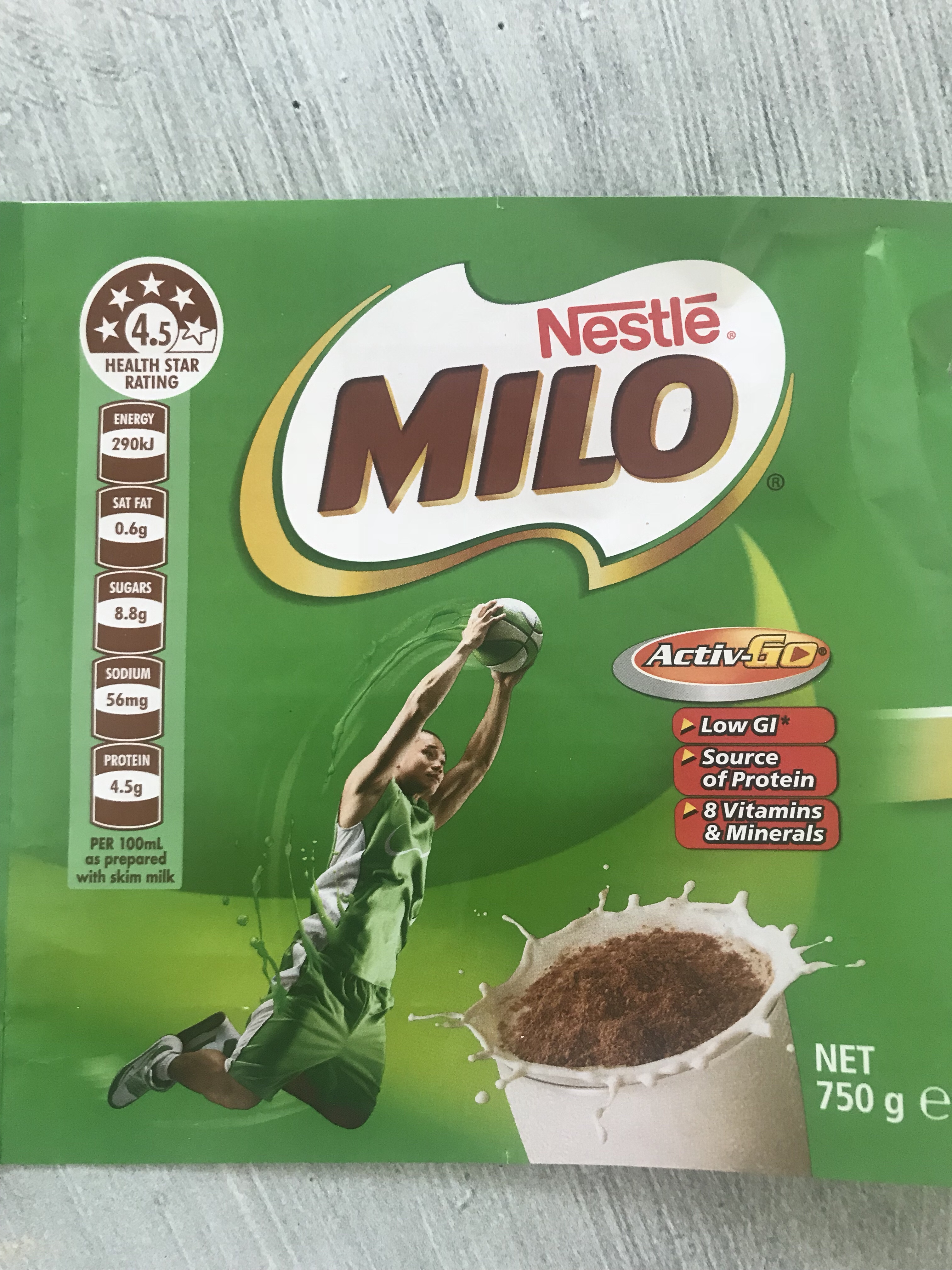HOW HEALTHY IS MILO (AND HOW DOES IT COMPARE TO OTHER CHOCOLATE POWDERED DRINKS)?
Just like Vegemite and tomato sauce, chocolate drinks are staples in the Aussie pantries. Kids love them and they provide a chance to get another serve of milk in. Milo has been in the news recently as Nestle has conceded to reduce the label’s 4.5 Health Star Rating (based on making up Milo with milk) down to the 1.5 stars it deserves for what you get in the tin. We know these powders are full of sugar but how bad are they really? And is there a healthier choice than Milo?

HOW HEALTHY IS MILO? AND HOW DOES IT COMPARE TO OTHER CHOCOLATE POWDERS?
When we wonder how good these drinks really are, what we really want to know is how much sugar is in them. The World Health Organisation recommends that we limit our intake of added sugars to no more than 6 teaspoons a day. Not only does the amount of added sugar vary between products, but also the type of sweetener used. Brands often add sweeteners, like stevia, sugar alcohols and aspartame to claim they are low sugar, or sugar-free. While swapping to these sugar alternatives gets around the issue of added sugars, they may not actually be that healthy.
Sugar alcohols (like erythritol) aren’t really a sugar (or alcohol!). They taste very sweet, but they don’t stick to our teeth like sugar, and we don’t absorb them very well. You get the taste, without the energy and with limited effect on blood sugars. Stevia is a herb that is much, much sweeter than sugar so only small amounts are needed. The trouble is, both stevia and sugar alcohols this means they can cause some discomfort like gas, bloating or diarrhea. Individual tolerance varies, so watch your portions. Children are typically being more sensitive to the digestive upset.
If you’re reducing sugar for weight loss, some studies show that switching to alternative sweeteners doesn’t actually help. Research into the safety and long-term use of stevia, sugar alcohols and artificial sweeteners is still ongoing as they are fairly new additions to our foods. There is some early evidence suggesting they aren’t actually healthier than sugar, they’re just not sugar. We need to wait for more research in this area to know for sure.
Whichever sweeteners you chose to eat, remember the bigger picture. It’s your total intake that counts and the variety of wholefoods that you eat in a day, a week and a year that really contributes to your health. The type of sweetener in a chocolate drink shouldn’t make a difference if you’re only having it now and again.

THE COMPARISON
Here is a round-up of 14 common chocolate powdered milks available at Coles and Woolworths. First is their ingredients, then scroll down for a comparison table.
INGREDIENTS
Chocolate powders are just a mix of sweeteners (cane sugar, stevia, alcohol sugars or artificial sweeteners), cocoa and sometimes added vitamins and minerals. I have changed the text colour the vitamins and minerals so you can easily see them in comparison to the other ingredients. Fortification with vitamins and minerals is helpful for people who could be elderly or unwell who may rely on drinks to boost their nutritional intake. I don’t recommend relying on these drinks as a boost for fussy eaters. It can reduce their appetite making family foods even less appealing.
Abundant Earth Organic Drinking ChocolateOrganic sugar, organic cocoa powder (23%), organic skim milk powder, natural flavour.
Akta-ViteSugar, Cocoa, (17%) Barley Malt Extract, Calcium Phosphate, Ferric Pyrophosphate, Calcium Ascorbate, Nicotinamide, Riboflavin, Thiamine Mononitrate, Retinyl Acetate, Folic Acid, Cholecalciferol.
AvalancheErythritol, Cocoa (Soy Lecithin), Natural Flavour, Stevia Extract, Salt.
Cadbury Drinking ChocolateSugar, Cocoa Powder, Starch (Maize or Tapioca), Mineral Salt (501), Flavour.
FangksNatvia Natural Sweetener (Erythritol, Steviol Glycosides), Cocoa (11%), Emulsifier (Soy Lecithin), Minerals (Calcium, Magnesium, Iron), Salt, Vitamins (C, B1, B2, A).
Jarrah Hot ChocMilk Solids, Cocoa (18%), Glucose Solids, Vegetable Fat and Oil, Salt, Mineral Salts (341, 340, 451, 452), Vegetable Gum (415), Sweetener (951), Flavour, Emulsifiers (471 or 472c, 481, 322 (Soy)), Anticaking Agent (551), Colour (160A).
HorlicksWheat Flour, Malted Barley (15%), Dried Whey, Mineral (Calcium Carbonate), Sugar, Vegetable Fat, Dried Skimmed Milk, Salt, Acidity Regulator (Potassium Bicarbonate).
MiloExtract of Malt Barley (16%) Or Malt Barley and Rice (Total Extract 35%), Milk Solids, Sugar, Cocoa, Minerals (Calcium, Iron), Maltodextrin (Corn), Vitamins (C, B3, A, B6, D, B2, B12), Emulsifier (Soy Lecithin). Contains Gluten, Milk and Soy.
Nesquick
Cane Sugar, Cocoa, Emulsifier (Soy Lecithin), Spice (Cinnamon).
Cane Sugar, Cocoa, Emulsifier (Soy Lecithin), Spice (Cinnamon).
Ovaltine
Milk Solids (45%), Malt and Barley Extract (27%), Glucose Solids, Cocoa (7%) (Contains Soy Lecithin), Vegetable Oil, Mineral Salts (341 or 340, 451, 452, 500, Iron Pyrophosphate), Flavours (Contains Wheat), Salt, Xanthan Gum, Sugar, Emulsifier (471 or 472c, 481), Sweetener (951), Anticaking Agent (551), Colour (160a).
Milk Solids (45%), Malt and Barley Extract (27%), Glucose Solids, Cocoa (7%) (Contains Soy Lecithin), Vegetable Oil, Mineral Salts (341 or 340, 451, 452, 500, Iron Pyrophosphate), Flavours (Contains Wheat), Salt, Xanthan Gum, Sugar, Emulsifier (471 or 472c, 481), Sweetener (951), Anticaking Agent (551), Colour (160a).
Republica Drinking ChocolateNatural sweetener (erythritol), organic fair trade cocoa powder (23%), natural flavour, vegetable gum, salt.
Sipahh Straw
Cane Sugar, Tapioca Starch, Cocoa Powder, Maize Maltodextrin, Flavour, Sweetener (Sucralose).
Cane Sugar, Tapioca Starch, Cocoa Powder, Maize Maltodextrin, Flavour, Sweetener (Sucralose).
SustagenNon Fat Milk Solids (51%), Sugar, Corn Syrup Solids, Cocoa (6%) (Contains Soy Lecithin), Whey Protein Concentrate (Milk, Soy Lecithin), Whole Milk Powder (Soy Lecithin), Flavour, Lactose (Milk ), Vitamins (Sodium Ascorbate, Tocopheryl Acetate, Niacinamide, Retinyl Acetate, Cyanocobalamin, Thiamin Hydrochloride, Folic Acid), Minerals (Ferrous Sulphate, Zinc Sulphate).
Vitarium Du Chocolat
Natvia Natural Sweetener (Erythritol, Steviol Glycosides), Cocoa (10%), Emulsifier (Soy Lecithin), Salt
Natvia Natural Sweetener (Erythritol, Steviol Glycosides), Cocoa (10%), Emulsifier (Soy Lecithin), Salt
The verdict: As with most packaged foods, going with the simplest ingredients list is usually a good start. None of the ingredients used above are dangerous, but eating foods with long ingredients lists too often, usually isn’t good for your long term health.
Now that we’ve seen what’s in these drinks, we need to find out just how much sugar is in it, using the nutrition information panel.

No comments:
Post a Comment